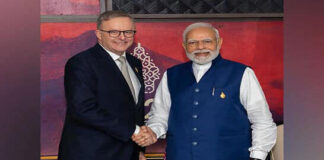AUGUST 9, 2023

HONG KONG — Tepid consumer demand and rising economic concerns in the world’s second-largest economy have tipped China into deflationary territory for the first time in two years, adding pressure on Beijing to act more aggressively to avoid a deepening economic malaise.
Instead of experiencing a surge in prices after the lifting of Covid-19 pandemic curbs late last year, China is suffering an unusual bout of falling prices for a range of goods, from commodities such as steel and coal to daily essentials and consumer products such as vegetables and home appliances.
China’s economic predicament stands in contrast to that of the U.S. and other developed Western economies, where soaring inflation after the lifting of Covid restrictions sent central banks, including the Federal Reserve, on an aggressive path of interest-rate increases aimed at cooling the economy without triggering a recession.
While falling prices in China may help ease inflationary pressure elsewhere as Chinese exports become cheaper, they could become the source of another concern for the global economy. For instance, a flood of low-price Chinese goods risks squeezing profits for producers in other countries and hurting employment opportunities.
Chinese consumer prices fell 0.3% in July compared with a year earlier. The latest available data for the U.S. showed that consumer prices rose 3% in June compared with a year earlier, the slowest pace in more than two years, while annual inflation in the European Union stood at 6.4%, easing from 7.1% in May.
For China, the absence of inflation reflects an imbalance in an economy characterized by ample supply and dormant domestic demand, the latter of which economists say Beijing must do more to rouse.
But that rebound petered out quickly. At the same time, investment by private businesses fell to below their prepandemic levels, hurt by intensifying geopolitical tensions with Western economies and regulatory crackdowns targeting some of China’s most lucrative industries.
Youth unemployment, meantime, has soared to a series of record highs, hitting 21.3% in June. Chinese exports, an economic bulwark during the Covid years, are now falling at their fastest pace in years as demand in the Western world dries up.
For now, Chinese policy makers are sanguine about falling prices, dismissing suggestions that deflation is here to stay. China’s central bank has trimmed interest rates several times this year, but neither fiscal nor monetary policy makers have launched any larger-scale stimulus measures, in part because of constraints such as elevated debt levels.
“The reality looks increasingly grim,” said Eswar Prasad, a professor of trade policy and economics at Cornell University and a former head of the International Monetary Fund’s China division. “The government’s approach of downplaying the risks of deflation and stalling growth could backfire and make it even harder to pull the economy out of its downward spiral.”
Prices charged at the factory gate, which have been contracting on a year-over-year basis since last October, fell 4.4% in July from a year earlier, narrowing from June’s 5.4% decline, according to data published by China’s National Bureau of Statistics on Wednesday.
But it was consumer-price inflation, which had remained positive even as producer prices turned negative, that marks the bigger shift. Last month’s 0.3% drop, after a flat June, was the first decrease since February 2021, a reading thrown off by year-over-year comparisons to the early days of the pandemic, when supply chains and food prices were in disarray.
Apart from November 2020, when the pandemic was rattling the economy, consumer and producer prices hadn’t been in deflationary territory together since 2009, at the depths of the global financial crisis.
July’s consumer-price deflation was mainly driven by a drop in food prices from a year earlier, when prices were pushed up by extreme weather conditions, a spokeswoman for China’s statistics bureau said Wednesday. Prices of pork, a staple of Chinese diets, plunged 26% in July from a year earlier. Vegetable prices also fell last month.
Stripping out volatile food and energy prices, so-called core inflation rose to 0.8% in July, the highest level since January, from 0.4% in June.
Even so, consumer inflation isn’t likely to pick up much this year, economists say. The reason is consumer confidence, or rather the lack of it, as households continue to feel the lingering impact of three years of Covid uncertainty, regulatory uncertainty and continuing concerns about the health of the property market. The real-estate sector, one of China’s main drivers of growth for decades, is in a deep funk, with fresh worries stoked this week by default concerns around one of China’s biggest property developers.
Unlike many countries in the West, where government cash handouts to consumers during the pandemic fueled a spending boom on physical goods such as furniture and personal electronics, Beijing so far has offered no such direct support to its households.
On top of that, a renewed downturn in the housing market has curbed Chinese consumers’ appetite for consumption, since many households have treated apartment units as their main store of wealth, and are highly sensitive to fluctuations in home prices, said Wei Yao, chief China economist at Société Générale.
“The problem is there’s no obvious driver to power recovery at the moment,” she said.
Apart from renovating an apartment that he purchased two years ago, Wang Lei said he and his wife’s overall expenditures have fallen compared with last year. Seeing colleagues and friends get laid off spooked him into reining in any unnecessary expenditures.
“It’s better to save more and be cautious now,” said Wang, 40 years old, who works at a videogaming company in Beijing. “The economic outlook is not certain.”
Even if consumer prices begin to pick up again, Chinese factory owners and exporters are likely to struggle with pricing power for some time, eroding their profit margins and hurting their willingness to expand production or hire more workers.
Even though producer-price deflation eased in July, the 4.4% drop was worse than 4.1% expected by economists polled by the Journal.
During the pandemic, many factories in China ramped up production to accommodate a surge in overseas orders. Now, as demand in the West fades, producers of automobiles, consumer goods and other products are being saddled with excess inventory, forcing many to slash prices to reduce stockpiles.
One manufacturer of robot vacuum cleaners based in the southern Chinese city of Shenzhen is looking to sell more overseas, in part because domestic rivals are offering cheaper options and the sluggish recovery in consumer demand has eroded sales at home, according to a company executive.
The ultimate challenge for Chinese policy makers is how to forestall a self-reinforcing spiral in which a fall in prices leads to reduced production, lower wages and suppressed demand.
Economists expect China’s central bank to lower interest rates further in the coming months, though many are skeptical that such moves alone can dispel deflationary pressures.
That is because confidence among businesses and households has been slow to recover, resulting in limited appetite for them to invest and spend more. Such an environment renders moderate stimulus measures largely ineffective, said Arthur Budaghyan, chief emerging markets strategist at BCA Research.
“The Chinese government has to do something very big to confront deflation,” he said. “I don’t think they’ve done enough yet.”
Courtesy/Source: WSJ










































































































